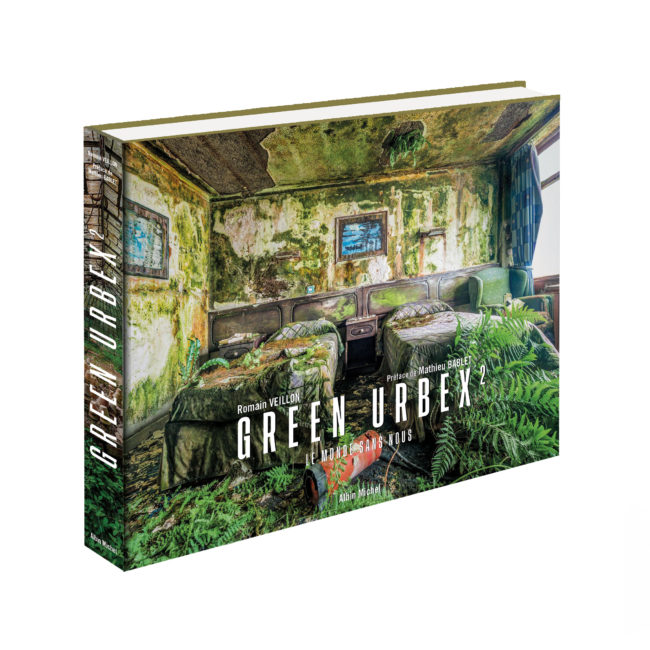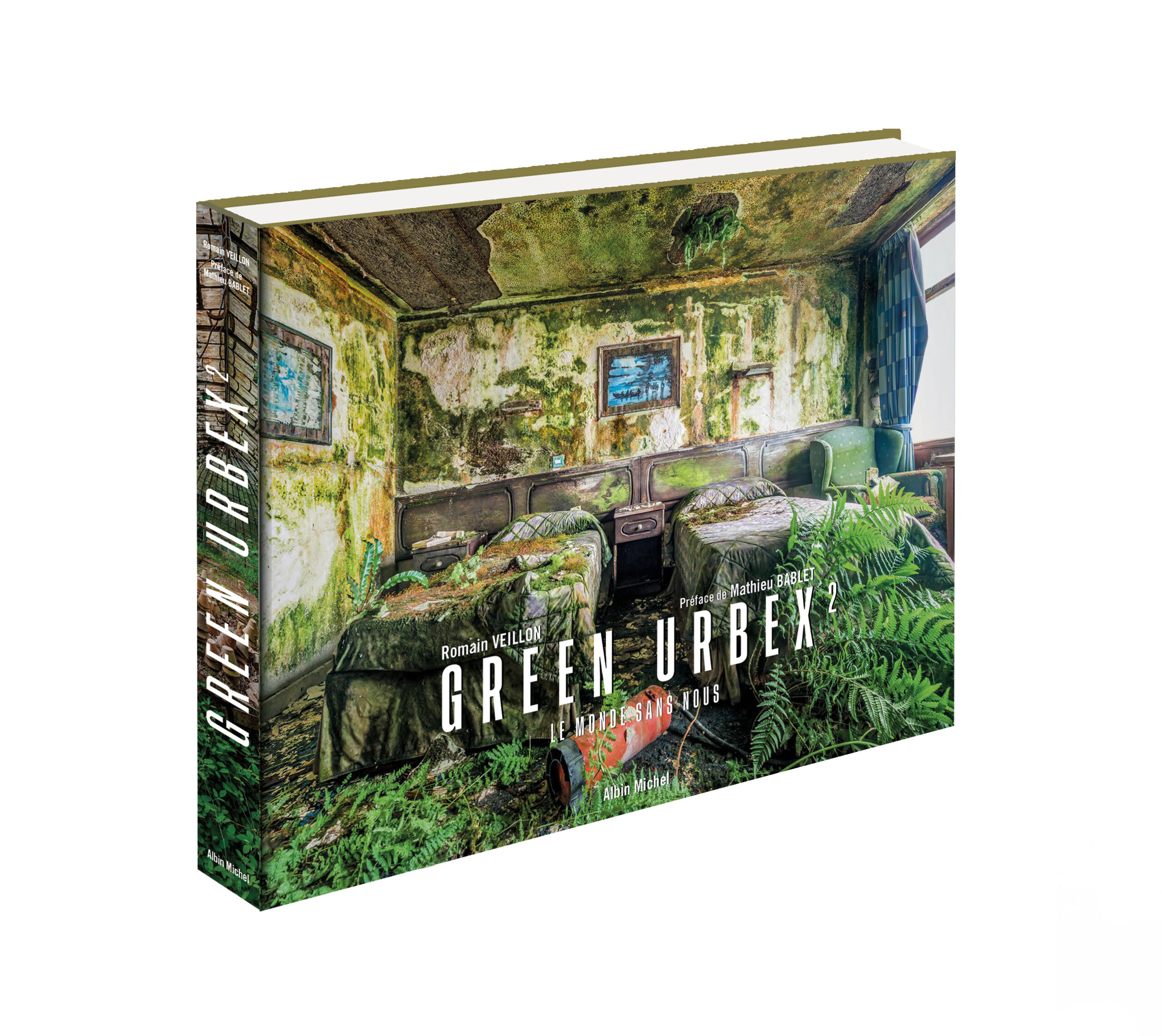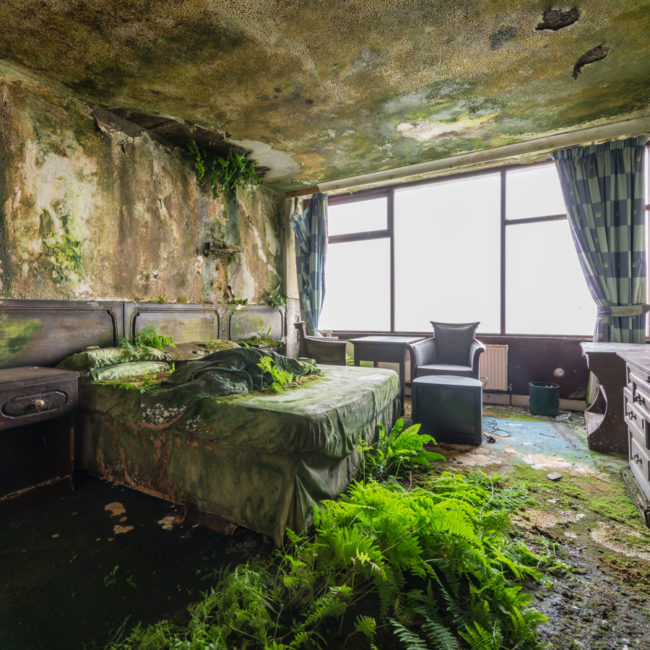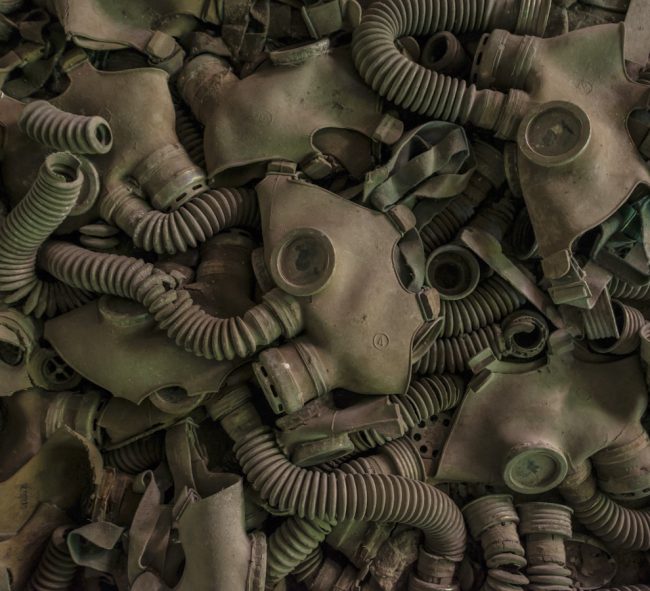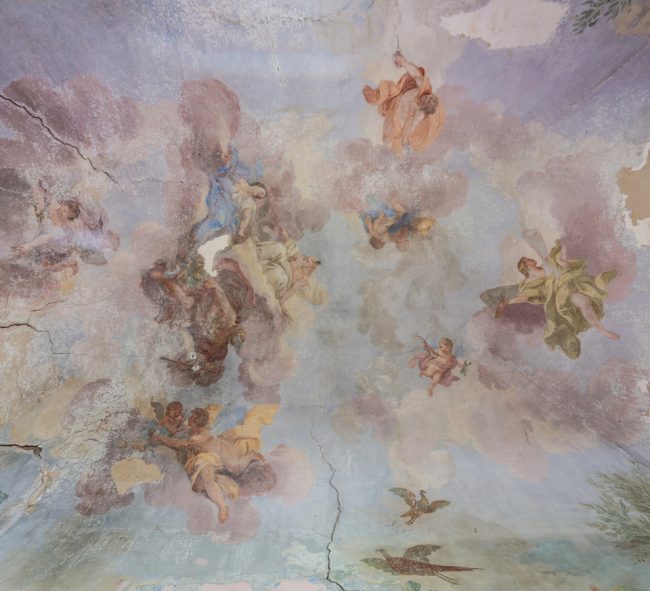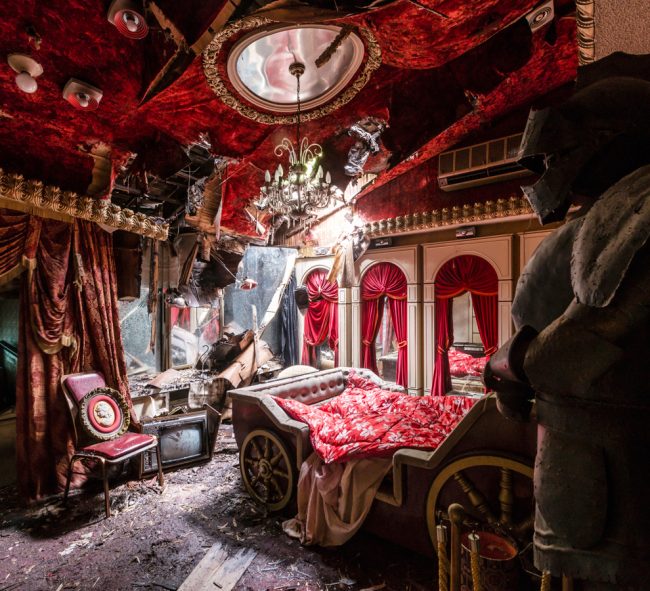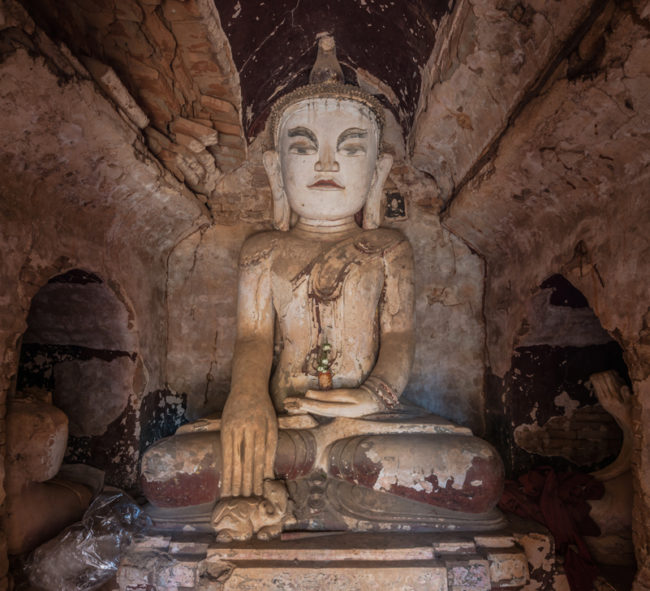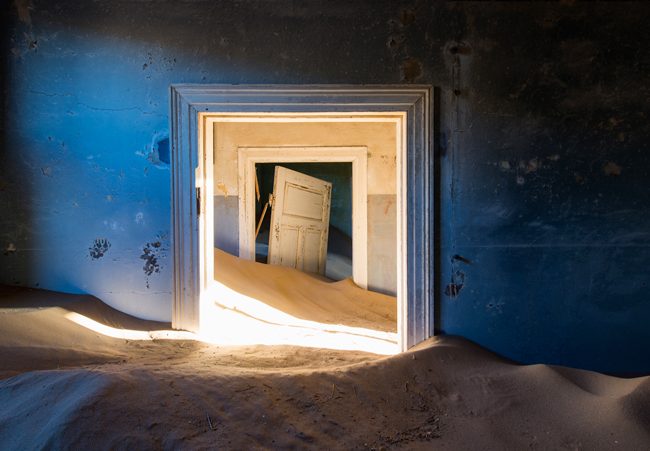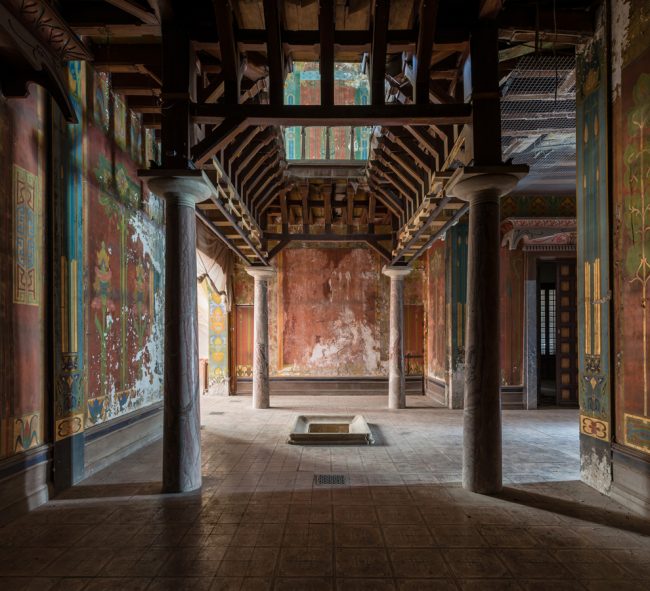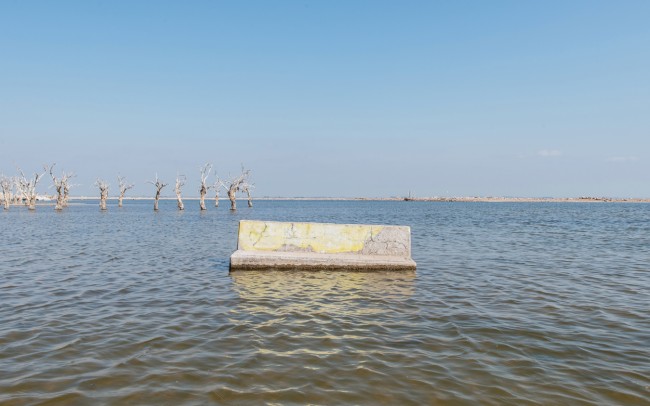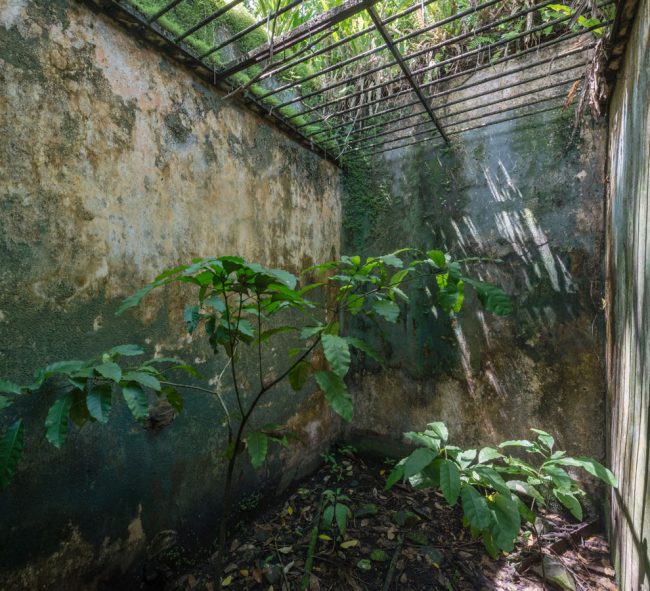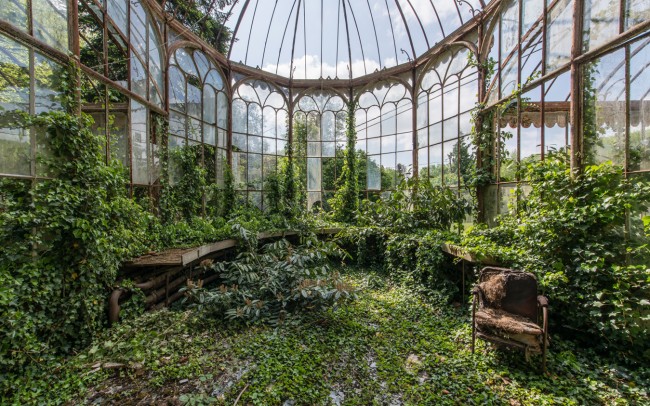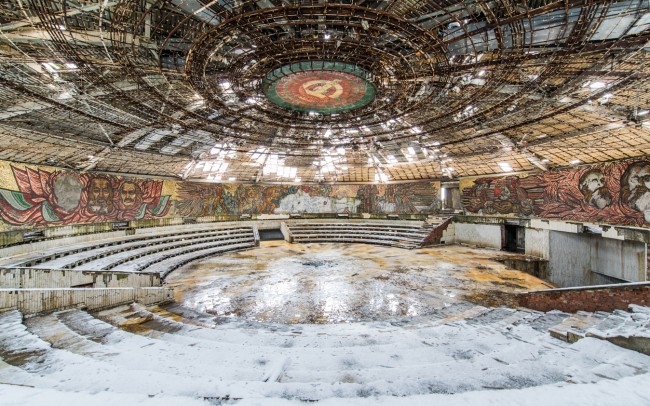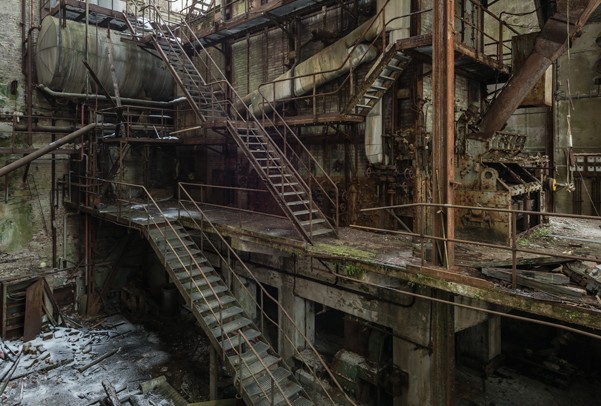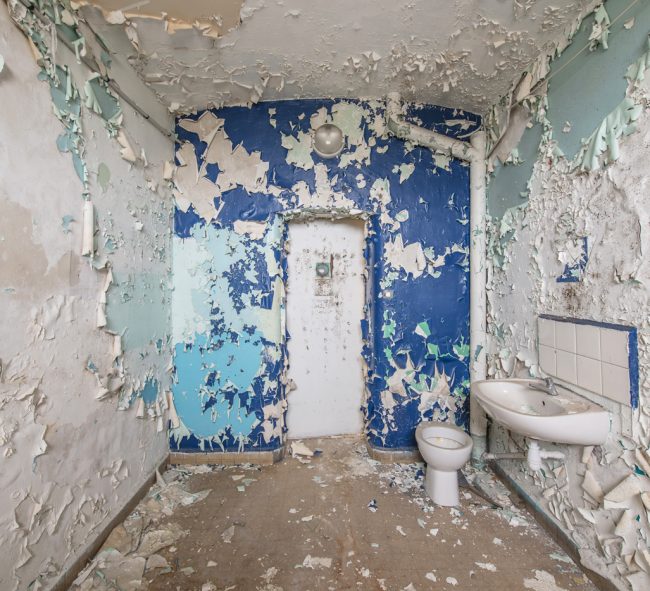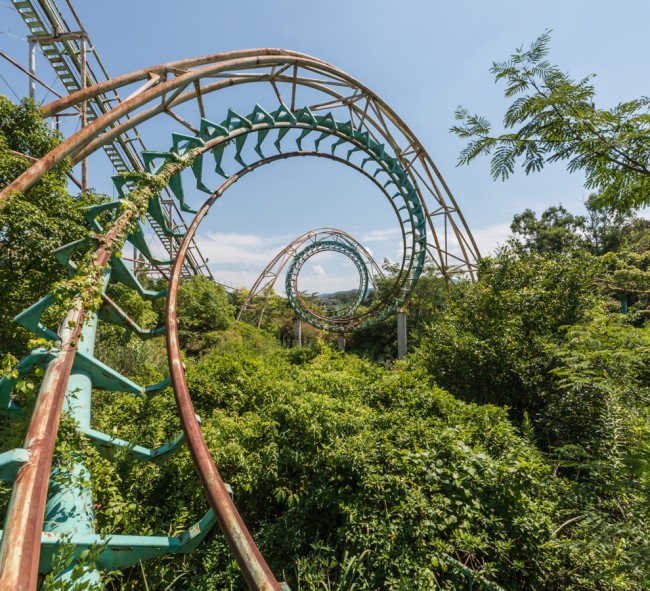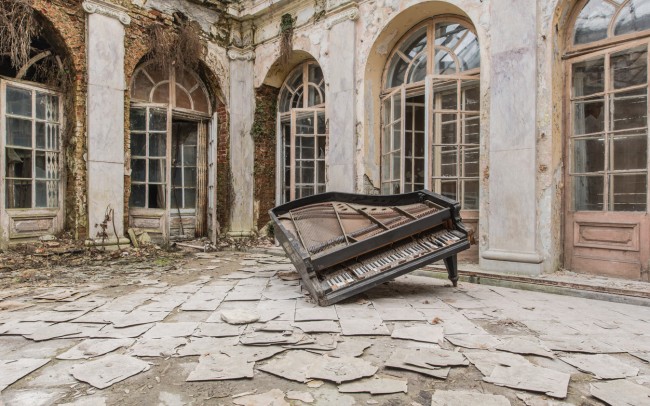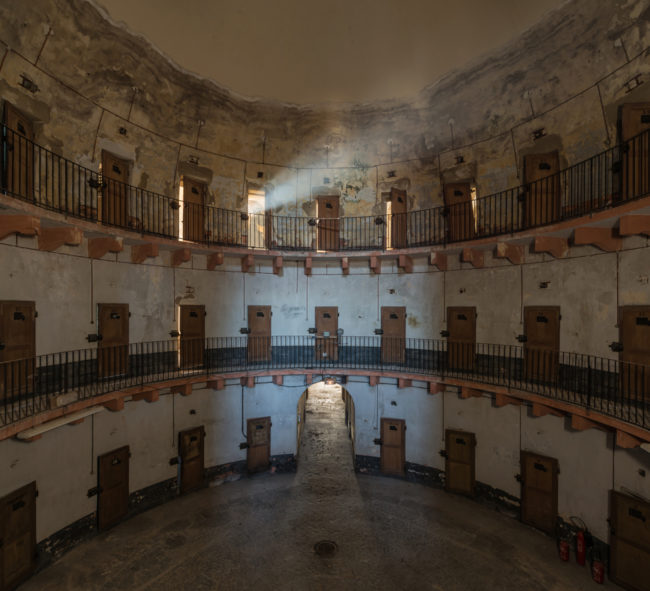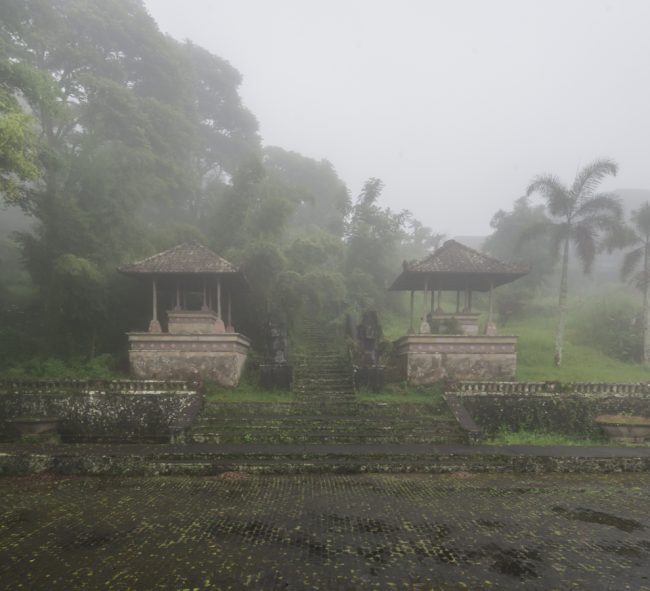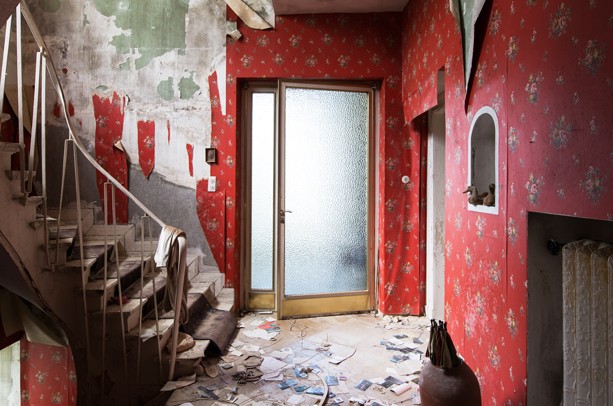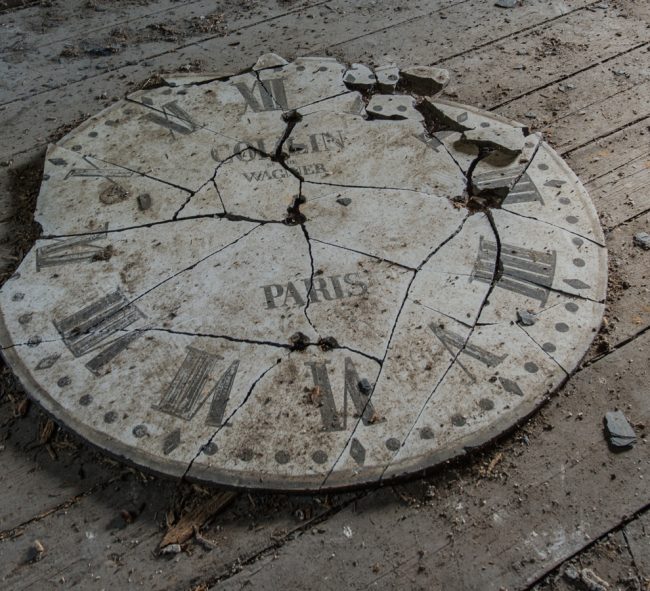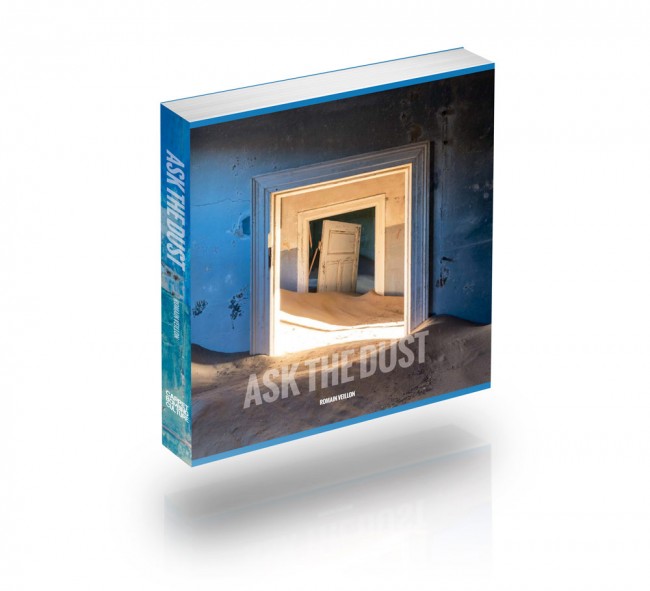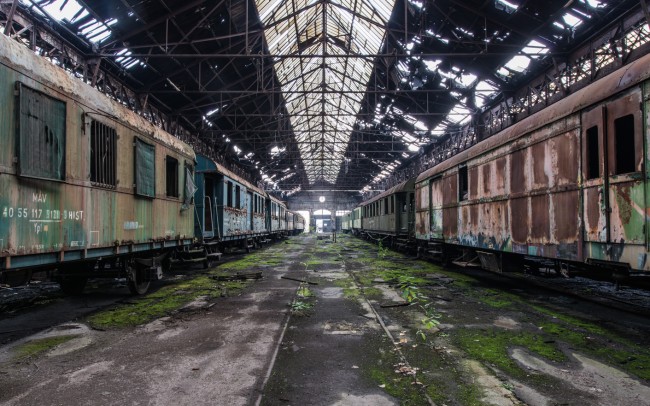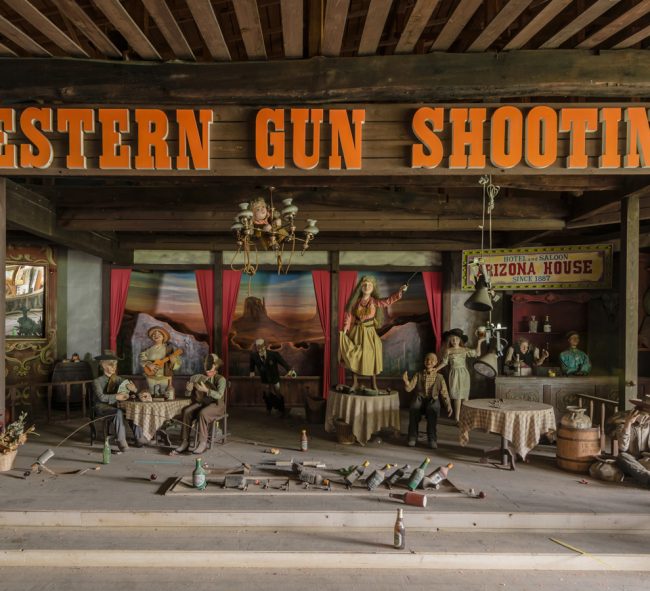During my last journey in Ireland, my attention was drown by an article in the local press about a former hotel that was closed for years. I decided it was worth a little visit during my next travel. I was completely astonished when i discovered what was inside! The rooms were fully recovered by vegetation, ferns and ivy! Nature really reclaimed its due here. Located on the coast, the wind and many storms of the area must have broke the windows and brought water inside daily so that it grew so much in a few years… It’s untouched, you can still find so many objects: phones, tables, books, chairs, old paintings, glasses, tvs, even hair dryers… When you have the chance to explore such an amazing place, you feel like in one of those post-apocalyptic shows where mankind disappeared from the face of the earth and where you wander through an empty world. It’s an eerie feeling, the atmosphere created is unbelievable and I hope I was able to give a faithful report in my photographs.
La ville de Tchernobyl est connue pour la catastrophe à la centrale nucléaire de Tchernobyl, bien que cette centrale se trouve dans la ville de Pripiat à 15 km au Nord-Ouest de Tchernobyl, qui a eu lieu le à 1 h 23, provoquée par la fusion du réacteur. La catastrophe a propagé dans l’atmosphère l’équivalent radioactif de 400 fois la bombe d’Hiroshima, ou de 0,5 fois une bombe nucléaire actuell et jusqu’à 4 000 personnes pourraient, à terme, décéder des suites d’une radio‑exposition consécutive à l’accident selon l’OMS3. Pour sa part, Greenpeace estime que 200 000 personnes contracteront un cancer résultant de la catastrophe nucléaire de Tchernobyl4.
Tchernobyl est incluse dans la zone de sécurité qui entoure la centrale et qui décrit un cercle d’un rayon de 30 km, censé être inhabité et où seuls les ouvriers de la centrale peuvent se déplacer. Cependant, certaines personnes sont retournées y vivre. Certains bâtiments ont été décontaminés pour y loger les ouvriers de la centrale nucléaire et d’autres ont été construits via des règles de sécurité bien spécifiques. La population de Tchernobyl était de 500 habitants environ en 2010 et a augmenté de 125 habitants en cinq ans pour une population totale de 625 habitants en 2015. En 2016, on recense 800 habitants et la population ne cesse de croître. L’autoroute P56 passe par la ville et relie la ville de Ivankiv à la ville de Chernihiv en passant par la Biélorussie.
Venez avec moi découvrir les merveilleuses peintures dont l’homme a orné ses demeures et qui ont été oubliées lorsque la vie quittât ces lieux. Ces œuvres d’une beauté incroyable et unique ne sont pas visibles aux yeux de tous comme peuvent l’être les peintures ou sculptures d’un musée. Abandonnés du regard du public, elles dépérissent peu à peu du fait du temps qui passe et se souviennent à quel point elles étaient admirées du temps de leur grandeur ! Ces photographies représentent un passé sublime, symbole d’une époque révolue. Il n’est pas facile d’envisager à quoi pouvait bien ressembler ces endroits mais c’est bien là l’intérêt de ce musée imaginaire….. Alors, imaginez !
Isolé en pleine campagne, le petit village d’Indein se trouve sur les bords du lac Inle en Birmanie et n’est accessible qu’avec une traversée en pirogue. Lorsque l’on accoste, nous découvrons alors plusieurs centaines de minuscules pagodes ou stupas qui entourent un escalier nous emmenant en haut du village. De là, nous pouvons contempler la multitude de flèches de ces temples qui crée une véritable mer de piques. On pense que les premiers temples datent du 3ème siècle avant J-C, mais une autre partie a été construite entre le 17ème et le 18ème siècle. A l’intérieur de ces pagodes, il reste encore de nombreuses statues de bouddhas devant lesquelles la population priait. C’est un témoignage unique qu’ont laissé les moines qui étaient venus à Indein pour répandre le bouddhisme en Birmanie. Aujourd’hui, les locaux rénovent petit à petit ces pagodes qui reprennent vie au fur et à mesure des efforts de la population.
Autrefois riche et opulente, Kolmanskop n’est plus aujourd’hui qu’une ville fantôme envahie par le sable au milieu du désert namibien près de la côte pacifique. Son histoire est aussi courte qu’elle est étonnante. En 1908, alors que la Namibie était toujours sous le contrôle allemand, un travailleur du chemin de fer nommé Zacharias Lewala trouva un diamant en travaillant sur la pose de nouvelles voies entre Keetmanshoop et Lüderitz. Il en parla autour de lui et plusieurs personnes trouvèrent elles aussi des diamants, puis de plus en plus. Au départ, les rumeurs selon lesquelles des mineurs avaient trouvé un filon furent reçues avec beaucoup de scepticisme. Mais bientôt elles enflèrent ; des diamants étaient vendus quotidiennement et les géologues avaient confirmé la présence d’un gisement. Kolmanskop était né.
La fièvre du diamant explosa et Kolmanskop fut pris d’assaut pour devenir très vite le centre névralgique de la région appelée “Sperrgebiet” à cause de ce gisement qui allait s’avérer être gigantesque. La légende voulait que même de nuit, il était possible de trouver des diamants dans le sable s’il y avait la pleine lune.
Kolmanskop émergea rapidement à partir de rien avec l’apparition d’immigrants venus s’y installer, et devint très vite une ville prospère et autonome. Construit sur un modèle d’inspiration allemande, on put vite y trouver un hôpital, une école, une épicerie, un boucher, une boulangerie, une fabrique de glace, un bowling, un casino, une salle de bal, une petite centrale électrique…
La soudaine prospérité de Kolmanskop attira bon nombre d’aventuriers, de chasseurs de fortune, de mineurs et autres prospecteurs à travers toute l’Afrique. Prospérité symbolisée par le fait que les habitants de Kolmanskop faisaient venir leur eau potable de Cape Town en Afrique du sud à plus de 1 000 kilomètres de là, recevaient un bloc de glaçon tous les jours et importaient leur Champagne de Reims! A son zénith, Kolmanskop accueillit plus de 1 200 personnes et 700 familles.
Alors que Kolmanskop continuait à grandir et que les diamants étaient toujours trouvés en profusion, le maire décida de construire la plus surprenante chose que l’on pouvait trouver au milieu d’un désert aride: une piscine! Les habitants et les mineurs pouvaient se relaxer là-bas après une dure journée de travail sous ce soleil de plomb. Pour cela, plus de 28 kilomètres de pipelines furent construites dans le désert pour atteindre la mer. Oui, en effet, c’était une piscine à l’eau de mer, l’eau potable était trop précieuse pour être gâchée même à Kolmanskop !
Si les villageois furent très heureux de l’arrivée de ce nouveau loisir, cette piscine devint bientôt le nouveau jouet des mineurs qui l’utilisaient pour nettoyer les diamants qu’ils avaient trouvé durant la journée dans leur concession au grand dam de leurs femmes.
A propos de l’hôpital, il est intéressant de noter qu’il possédait la première machine à rayon-x du continent africain; malheureusement cette machine était presque exclusivement utilisée pour vérifier si les mineurs n’avaient pas avalé de diamants. L’hôpital possédait aussi une maternité, une salle de cinéma et sa propre cave à vin! (Un des docteurs croyaient que le vin et le champagne aidaient à une guérison rapide).
Après la première guerre mondiale, la ville commença à décliner à cause de la chute du cours du diamant et de la récession de l’économie allemande. Puis, la capitulation de l’armée allemande à l’Afrique du sud amena à de nombreuses dépossessions de concessions.
Peu à peu, les habitants quittèrent la ville laissant derrière eux maisons et affaires. La découverte en 1928 d’un gisement encore plus important plus au sud et l’épuisement de celui de Kolmanskop enterra leurs derniers espoirs. Oranjemund fut fondé en 1936, familles et prospecteurs s’y installèrent aussitôt. Utilisé pour le stockage pendant les années cinquante grâce à sa position géographique, la ville fut complètement abandonnée en 1956 et laissée la merci des éléments. Depuis, la ville est inexorablement enseveli sous le sable.
En 1980, le gouvernement Namibien réalisa qu’il existait un vrai potentiel pour transformer cette ville fantôme en attraction touristique. Ils rénovèrent quelques bâtiments, protégèrent certains autres et organisèrent des visites guidées à Kolmanskop. Malgré leurs efforts, les dunes progressent inexorablement et recouvrent les vestiges du village en enterrant les derniers souvenirs de la vie des anciens habitants. Aujourd’hui, Kolmanskop n’est visité que par quelques curieux venus s’aventurer dans cette région loin de tout pour imaginer quelques heures ce que devait être la vie d’un prospecteur de l’époque.
L’histoire du château Laurens est incroyable ; à tel point qu’on peut penser qu’elle provient de l’imagination d’Alexandre Dumas. Emmanuel Laurens lui aurait surement inspiré de nombreuses aventures. Né en 1873 dans une famille bourgeoise, ce dernier va se passionner très vite pour les voyages. Alors qu’il parcourt le monde, il hérite à 24 ans de l’immense fortune d’un lointain cousin, puis de celle de son père qui meurt la même année et qui lui lègue en plus un terrain à Agde.
Malgré une méconnaissance totale du métier d’architecte, il décide de dessiner lui-même les plans de la future villa qu’il va construire sur ce terrain en s’inspirant du courant « art nouveau ». Il souhaite que sa villa devienne une sorte d’œuvre d’art en elle-même où se conjuguent architecture, décor, mobilier et art de vivre. Chaque pièce lui rappelle un de ses voyages (pièce japonaise, patio italien, salle mauresque, etc.…). Des artistes marqués par le courant Art Nouveau comme le peintre Eugène Dufour, le décorateur Léon Cauvy, ou l’artiste Eugène Simas s’occupent de décorer la villa. En 1920, il épouse la cantatrice Louise blot et lui fait construire un salon de musique avec un dôme comme une chapelle pour que sa voix soit mise en valeur. Emmanuel Laurens mène alors grand train avec sa famille et ses amis pendant des décennies.
Mais des dépenses fastueuses et des investissements hasardeux épuisent sa fortune, et il se retrouve obligé de vendre le château en viager en 1938. Il vit alors chichement dans une petite dépendance de la villa avec sa mère et sa femme. Pendant la seconde guerre mondiale, le château est occupé par les allemands ; on dit qu’Emmanuel Laurens préfère couler de nombreux meubles et objets dans le lac pour que les nazis ne puissent pas les récupérer. Devenu dépendant à l’opium, Emmanuel Laurens n’a plus aucune ressource. Sa femme meurt en 1954, il la suit en 1959 alors qu’il vit dans les rues d’Agde comme un vagabond.
Tombé dans l’oubli, le château Laurens est fortement endommagé après toutes ces années laissé à l’abandon. Il fut racheté par la ville en 1994 ; puis la Communauté d’agglomération Hérault Méditerranée Occitanie décidât de lui redonner une deuxième vie en la rénovant entièrement et en l’ouvrant au public en 2020. Peut-être que la villa nous révèlera de nouveaux secrets sur son histoire !
Le destin de l’ancienne ville thermale d’Epecuén en Argentine fut aussi tragique qu’original. Situé à environ 500 kilomètres au sud de Buenos-Aires, Epecuén a été fondé au début des années vingt sur les berges du lac éponyme. La légende veut que ce lac fût créé par les larmes d’un grand chef guerrier à la mort de sa bien-aimée.
Le lac était célèbre pour sa teneur en sel (dix fois plus que l’eau des océans). On dit même qu’il était aussi salé que la mer morte ! Bien entendu, cela attirait beaucoup d’Argentins et autres touristes sud-américains qui cherchaient à s‘échapper le temps d’un weekend tout en bénéficiant des propriétés curatives des eaux salines.
Rapidement, cette station connut un succès fulgurant attirant plus de 20 000 touristes par an pour une population locale de seulement 1 500 habitants (en grande partie grâce à la ligne de chemin de fer qui reliait la ville à Buenos Aires). Plusieurs hôtels furent construits pour contenter la demande grandissante; puis des discothèques, restaurants, magasins de vêtements et autres boutiques et même un château d’inspiration française! Epecuén était en train de devenir l’une des destinations à la mode d’Argentine.
Malgré ce succès croissant, la population d’Epecuén était déjà au courant que les digues n’étaient pas assez solides et devaient être consolidées pour éviter le pire. Mais le gouvernement ne débloqua jamais les fonds nécessaires et laissa trainer le problème. Le 10 Novembre 1985, il fût trop tard, l’inévitable arriva : Alors que de fortes pluies tombaient depuis quelques semaines dans la région, les digues qui protégeaient la ville cédèrent.
En une dizaine de jour, la ville fut complètement engloutie sous une dizaine de mètres d’eau et ces habitants furent obligés de s’enfuir. La plupart n’eurent pas le choix et durent partir avec le peu de choses qu’ils avaient réussi à sauver, laissant derrière eux une partie de leur vie.
Les années suivantes, les eaux stagnèrent et Epecuén resta englouti. Les anciens résidents perdirent espoir, certains s’installèrent à Carhué qui était la ville la plus proche, d’autres préférèrent quitter la région car la peine d’avoir tout perdu était trop grande.
PAPILLON
« La silencieuse », « La mangeuse d’homme » ou bien « La guillotine sèche » ; ce n’est pas les expressions qui ont manquées pour décrire la dureté et l’horreur qu’allaient devoir affronter les prisonniers qu’on envoyait au bagne des bagnes : la redoutable île Saint-Joseph.
En effet, c’est au large de Kourou, dans les «îles du salut », que l’on se débarrassait des bagnards les plus récalcitrants de Guyane (ceux qui avaient volés, assassinés ou qui avaient déjà tentés de s’échapper). Les conditions de captivité y étaient effroyables. Détenus dans des cellules minuscules, ils avaient interdiction de parler, de fumer, d’écrire, de détenir un objet ou de s’assoir avant la nuit. Les prisonniers n’avaient rien à faire d’autre que de tourner en rond dans leurs cages où la lumière du jour ne pénétrait jamais. La chaleur étouffante, l’humidité, les nombreuses maladies, le manque de nourriture et les punitions des surveillants rendaient leur quotidien encore plus inhumain. Pas étonnant alors que leur espérance de vie soit aussi basse: un détenu sur trois y mourrait ; le reste parvenait à survivre mais avec des séquelles qui les poursuivraient jusqu’à leur mort (scorbut, tuberculose, aveuglement, folie, etc.…).
C’est avec curiosité que je suis parti sur les traces de ce qui fut un véritable enfer sur terre et surtout le témoin d’une des pages les plus honteuses de notre histoire. Ce voyage fut à la fois enrichissant et surprenant car il y a un vrai paradoxe entre la beauté de ce lieu et l’usage qui en a été fait. Avec cette série de photographies, j’ai voulu m’interroger sur cette contradiction qui paraissait essentielle à mes yeux. Pour cela, j’ai essayé de retranscrire de la façon la plus fidèle possible l’atmosphère chargée de souvenirs qui ressort de ses ruines. Lorsqu’on ignore l’histoire de l’ile Saint-Joseph, les cocotiers, la mer turquoise et le sable fin peuvent la faire apparaitre comme un endroit idyllique. Mais quand on sait ce qui s’y est déroulé pendant presque un siècle, cette vision se transforme et on découvre à quel point ce châtiment était en lui-même un crime. L’évolution végétale naturelle depuis la fermeture du bagne et comment les plantes ont désormais repris possession des lieux m’a ausi fasciné. Arbres, racines et lianes sont désormais en train de recouvrir chaque parcelle des murs et des couloirs. Si rien n’est fait, il est probable que les derniers vestiges du bagne soient rapidement détruits par la végétation. Il ne sera alors plus possible d’imaginer les fantômes des bagnards errer comme des âmes en peine à travers ces couloirs.
Une question se pose alors : Doit-on laisser le temps effacer nos erreurs passées ou au contraire doit-on les sauvegarder pour ne pas les oublier et surtout ne pas les reproduire ?
Que se passerait-il si l’homme disparaissait soudainement de la surface de la terre?
Essayer d’imaginer la réponse fascine les gens depuis la nuit des temps. Ce qui est intéressant est que nos réponses varient en même que la société évolue et change. La première chose qui nous vient à l’esprit est que la végétation va se répandre et recouvrir toutes les constructions humaines. Effectivement, c’est le changement visuel le plus impressionnant qui aura lieu en premier. Ce n’est pas une surprise si l’illustration du mot « abandon » renvoie vers un vieux château en ruine recouvert de mousse et de plante.
Mais ce n’est pas le seul. Depuis son apparition, l’être humain a eu un impact colossal sur la planète. De remodeler la surface de la terre jusqu’à changer la composition de son atmosphère. Donc, que se passerait-il si l’homme venait à disparaitre tout à coup de la surface de la terre?
What would happen if mankind suddenly disappear from earth?
Trying to imagine the answer has fascinated people since the dawn of time. What is interesting is that our answers vary in the same time that our society changes and evolves. The first thing to come to mind is that vegetation is going to spread and take back what’s his own on swallowing all human constructions. Indeed, this change is the most impressive and visual one that will come first. It’s not a surprise if the illustration of the word « abandon » always refer to a very old castle recovered by mold and ivy.
But that won’t be the only change. Since their first appearance, human beings had a huge impact on the planet. From restructuring the shape of the earth to changing the composition of its atmosphere. It is impossible to say precisely how much time it will take for the flora and fauna to overcome the damages made by Men. The examples of Chernobyl and of the atoll of Johnston in the pacific where the American government had 12 nuclear warheads explode are nowadays the places on earth where the biodiversity is the strongest. This shows us that life will always find an extraordinary way to survive and blossom. Imagine, in 500 years, forests will be back in the state they were more than 10 000 years ago!
With this series called « Luxuria », I hope to show in a very aesthetic and graphic way this world where Mother Nature has already reclaim its heritage. To me, those images serve as some kind of Memento Mori : This is what the planet could look like if we continue to not care about the environment that surround us which will lead to our disappearance. They remind us that we all die and that everything comes to an end eventually. We are only passing through. Like a prediction of the future, the consequences of our acts are illustrated by these photographs. If Men is physically missing of these places, his presence is still tangible everywhere. And that’s this proximity with our society that interest me; this very thin line between today and a possible tomorrow. If we really are the most advanced species as we pretend to be, wouldn’t be possible to create a way of letting nature thrive in harmony with our way of life without mankind vanishing from the planet?
Enjoy the journey !
Curieuse histoire que celle de Buzludzha, OVNI perché à plus de 1 400 mètres d’altitude au sommet du mont éponyme. Inauguré en 1981, l’œuvre de l’architecte Guéorguy Stoilov est perdue quelque part en plein centre de la Bulgarie et demeure encore aujourd’hui une anomalie architecturale unique ainsi que le symbole d’une époque révolue.
Conçu à l’origine pour devenir la salle de congrès du parti communiste (elle ne servit qu’en de rares occasions), sa construction fut en outre motivée par le souhait de commémorer la création du mouvement socialiste. Car c’est en effet à Shipka, petite bourgade des environs, que les fondateurs du parti socialiste se réunirent en secret pour la première fois pour poser les bases du mouvement. La construction de Buzludzha accapara plus de 6 000 travailleurs pendant 7 ans et coûta la modique somme de 7 millions d’euros dont le financement incomba bien entendu en grande partie au peuple bulgare. Le décor intérieur comptait de sublimes fresques et mosaïques dessinées par les plus grands peintres et sculpteurs du pays; et où figurait les grands thèmes chers aux soviétiques (révolution rouge, lutte du peuple, famille, et même conquête spatiale). On trouvait aussi au dessus de l’auditorium une gigantesque coupole recouverte par plus de 30 tonnes de cuivre et arborant fièrement le marteau et la faucille communiste accompagnés du slogan « Prolétaires de tous les pays, unissez vous ! ». Ce qu’ils firent quelques temps plus tard, mais dans un tout autre but que celui auquel pensait Marx quand il l’a prononcé.
Suite à la chute du communisme en 1989, le monument se retrouva abandonné et en proie aux pillards de tout genre. Peu reconnaissant des « bienfaits » du communisme, ses derniers s’unirent donc, mais surtout pour voler en l’espace d’une nuit tout le cuivre présent dans le bâtiment. Ils en profitèrent au passage pour détruire la mosaïque de leur ancien leader: « Todor Jivkov » en guise de remerciement mais épargnèrent bizarrement les autres dirigeants historiques. Depuis, Buzludzha se dégrade lentement mais surement en raison des intempéries et du vandalisme.
Devenu un lieu de pèlerinage autant pour les photographes aventuriers que pour les nostalgiques de Staline, cet étrange vaisseau spatial continue de trôner sur sa montagne comme s’il allait bientôt décoller, nous laissant méditer sur cette phrase que prononça le premier ministre bulgare au moment de céder le bâtiment au parti socialiste bulgare en 2011: « Un pays qui ne respecte pas son passé et ses symboles n’a pas d’avenir ».
Depuis le début du 19ème siècle, l’industrialisation et sa première révolution a remodelé le paysage des pays développés de l’hémisphère nord. La transition d’une production aux méthodes manuelles à de nouvelles techniques et procédés mécaniques de manufactures a marqué un tournant majeur dans la vie de la population de l’époque. La routine du quotidien de travail fut complétement chamboulé et cela a amené de fortes améliorations des conditions de vie.
Puis, la deuxième révolution industrielle arriva vers 1850 avec comme conséquences la progression de la production d’acier et de fer, le développement du réseau ferré grâce aux machines à vapeur, l’apparition de l’essence et de produits chimiques, l’essor de l’utilisation des machines dans l’industrie et les balbutiements de l’électricité.
Cette révolution développa un nouveau type d’industrie et d’usines uniques en leur genre (et souvent de taille gigantesque) qui prospérèrent pendant de longues années avant qu’un grand nombre furent fermées puis progressivement abandonnées. Il y a plusieurs causes à cela, mais nous pouvons en ressortir trois principales.
La mondialisation fut de loin la cause principale à ces fermetures. De nombreuses usines ont décidé de délocaliser dans des pays étrangers (principalement en Asie) où la main d’œuvre est bien moins cher. Associé à cela, l’épuisement de ressources naturelles comme le charbon par exemple est responsable de la fermeture de nombreux sites miniers. Enfin, l’obsolescence des machines utilisées et la modernisation des techniques de travail a fait fermer les plus beaux sites de notre héritage industriel.
Pendant longtemps, ce qui restait de ces monuments industriels n’était pas réellement considéré comme un héritage que nous devions protéger et fut délaissé pour plusieurs raisons. Tout d’abord, le traumatisme économique et social qui suit une fermeture définitive, mais aussi les problèmes de pollution qui apparaissent sur les sites et le relatif espoir qu’ont certains travailleurs de voir l’usine rouvrir un jour lors de temps meilleurs.
Installée dans une ancienne abbaye cistercienne, cette prison fut tour à tour un dépôt de mendicité, une maison de correction, une colonie agricole et un centre de détention. Elle pouvait accueillir plus de mille prisonniers répartis dans plusieurs ailes mais doit fermer en 2011 pour cause de vétusté.
Désormais vouée à une démolition certaine, le temps semble suspendu comme si les murs avaient encore des histoires à raconter.
A peine rentré, c’est un sentiment d’oppression et de tristesse qui s’empare de nous. Forcément chargé d’histoire, ce lieu si particulier n’est pas une visite comme les autres. Il vous oblige à vous remémorer tous les fantômes qui y sont passés et tous les rêves qui s’y sont brisés. Sans le vouloir, on se met à la place de toutes ses ombres qui ont défilées à travers ces couloirs obscurs et un léger frisson qui n’a rien d’agréable se fait ressentir. On ne peut s’empêcher d’imaginer à quoi devait ressembler leur quotidien et les tourments qu’elles ont du y connaitre comme le montre de nombreux témoignages gravés dans la roche. « Si tu plonges longtemps ton regard dans l’abime, alors l’abime te regardera longtemps à son tour » disait Nietzsche. En effet, je crois qu’il est temps de s’échapper.
During my last trip in Japan, I had the chance to visit the most famous abandoned amusement park in the world: Nara Dreamland!
Built in 1961, Nara Dreamland was supposed to be the “disney” theme park of the country, which is easy to guess when you take a look on the fairy pink princess castle ! It was a huge success and many japanese went there during their free time for many years.
It was an incredible feeling to be able to explore this place during an entire day and imagine how it was to be on the roller coaster or just to wander in the little streets of this paradise.
But the opening of the real Disneyworld in Tokyo and the Universal studios in Osaka was too much competition for Nara Dreamland. By 2006, the theme park closed and became another dream for explorers, urbex aficionados and photographers as one of the most famous haikyo in Japan!
Now, nature reclaims the park, which disappears slowly under the vegetation and create an even more magical and unique atmosphere.
Construit en 1961, Nara Dreamland était un parc d’attraction japonais situé à Nara dans la banlieue d’Osaka. Son concept avait été imaginé par l’homme d’affaires Kunizo Matsuo qui lors d’un voyage aux Etats-Unis avait été ébloui par le parc d’attraction Disneyland au Japon. Il entra alors en contact avec Walt Disney pour créer la version japonaise de son parc. Malheureusement, certaines divergences artistiques et commerciales mit fin à leur collaboration. Mais pas de la motivation du riche entrepreneur. Il décida alors de créer une copie de Disneyland en développant un univers s’inspirant fortement de son ainé américain. Le parfait symbole étant le château de la belle au bois dormant qui dominait toutes les attractions au milieu du parc.
Lors des premières années, Nara Dreamland connut un véritable succès au cours des premières années, les japonais étant très friand à la fois de parcs d’attraction mais aussi de l’univers « américain » proposé. En plus du château de princesse, il y avait de nombreux manèges, un parc aquatique, une maison hantée, des bornes d’arcade, des auto tamponneuses… Mais l’attraction la plus célèbre était les montagnes russes « Aska » qui fit la renommée du lieu. À son apogée, plus d’ 1,7 million de visiteurs arpentaient le parc par an. Malheureusement, le rêve allait prendre fin subitement. En effet, l’ouverture du véritable Disneyland Resort à Tokyo en 1983 freina fortement la fréquentation et fut un coup dur pour Kunizo Matsuo. Puis l’ouverture d’Universal Studios à Osaka en 2001 porta le coup de grâce à Nara Dreamland et la fréquentation connut une chute vertigineuse, Le parc est obligé de fermer définitivement ses portes le 31 août 2006.
Nara Dreamland fut finalement démoli en 2016 après que la ville de Nara ait récupéré le terrain auprès du propriétaire endetté. Il ne reste aujourd’hui plus rien de ce qui fut un lieu mythique pour beaucoup de japonais ; seules quelques images et les souvenirs émerveillés d’anciens visiteurs font perdurer sa légende.
S’il y a bien un type d’endroit où notre imagination peut s’enflammer et créer les histoires les plus étonnantes, c’est bien ceux dédiés au loisir où nous nous amusions après le travail ou pendant les vacances pour échapper au stress de nos vies quelques heures. Pour certains, c’était une soirée au cinéma pour regarder un film ou une pièce au théâtre; pour d’autres, c’était une après-midi à nager à la piscine; jouer pendant des heures au piano pour se relaxer, transpirer à la salle de sport ou sur un terrain avec ces amis pour se défouler quand certains préfèrent aller boire dans un bar, danser toute la nuit ou jouer au casino.
While exploring Bali, I had the chance to explore this incredible abandoned hotel lost in the highlands of the island.
Mystery surrounds the hotel’s construction as well as its owner’s origin and many theories surround its legends. Some say that the real estate developer was cursed because of his corrupt projects. Some say all the guests suddenly disappeared one night and that their ghosts came back to haunt the hotel. The most likely scenario is that is was an investment project of Tommy Suharto, the son of former Indonesian President. After being sent to jail because of having tried to murder his judge in a corruption case, the hotel was never finished even if it was nearly completed.
Now abandoned for over a decade, vegetation took over and is slowly recovering the hotel. Being able to wander in these walls was a unique chance. The eerie atmosphere grows and makes the exploration both scary and unreal. Even if it’s impossible to know the truth behind this hotel’s origin, the feeling you have tells you something went wrong there…
Just when I was leaving, fog arrived and swallowed the hotel in a few minutes. i took this opportunity to make some last shots when it was still possible to see something. Not long after, you couldn’t see five steps away from you. The ghosts were back in their home and it was time for me to leave…
Enjoy this travel in the past!
Une des questions qui revient le plus souvent lorsque je parle de mon travail est: “Mais pourquoi ces merveilles sont délaissées, quelles histoires expliquent cet abandon” ? De par mon expérience et les discussions que j’ai eu avec les gens intéressés par le même univers que moi, je me suis rendu compte que les récits écrits à l’intérieur de ces lieux fascinaient autant les gens que les photographies elles-mêmes.
Et cela arrive surtout lorsqu’ils regardent des images de maisons, villas et châteaux où vous pouvez trouver de très nombreuses reliques de la vie des gens. Mais qu’est ce qui nous captive à ce point-là dans ce qui représentait le foyer?
J’imagine que c’est parce que l’on y voit un reflet de ce que pourrait devenir notre propre maison, ou celle d’un de nos proches où l’on a passé des moments inoubliables. Ils peuvent y identifier leurs souvenirs. Et je crois que tout le monde adore imaginer quel genre d’histoires a pu se dérouler lorsque les lieux étaient occupés.
Si on réfléchit, nous passons un tiers de notre vie dans notre lit, et encore plus pour certains ! Plus de la moitié de notre vie est dédiée à dormir dans notre chambre, regarder la télévision dans le salon, se laver dans la salle de bain, manger dans la cuisine, nettoyer l’entrée….
Notre foyer est donc une version de nous-mêmes, un endroit où nous nous sentons bien et que nous avons décoré à l’image de ce que nous aimons. Pour certains, ils veulent se sentir comme dans un nid pour être en sécurité. Pour d’autres, ils vont privilégier le coté esthétique de leur maison pour laisser libre cours à leur créativité et vivre dans un endroit qui leur ressemble. Parfois, il s‘agira de la maison familiale où des décennies d’histoire et d’héritage présent et passé sont empilées du sol au plafond.
Chacune de ces pièces contient une partie d’histoire, quel meilleur endroit alors pour découvrir le passé de quelqu’un que l’endroit qui fut le centre de sa vie ?
Grâce aux objets encore présents, on peut jouer les détectives et imaginer comment était la vie des anciens locataires. Une vieille photographie de mariage oubliée par terre exprime beaucoup plus d‘émotions qu’aucuns mots ne pourra. Les chambres elles-mêmes sont les témoins d’un temps révolu: La table où on avait l’habitude de diner, le lit marital, la vieille bibliothèque ou les escaliers grinçants que l’on grimpait en quatrième vitesse pour aller jouer. Chaque meuble ou objet nous invite à fabriquer notre propre histoire sur le passé de la maison.
Ce n’est pas seulement les objets ou les meubles d’ailleurs, ça peut aussi être un dessin sur le mur, la vue de la fenêtre ou bien juste l’atmosphère que l’on ressent dans le lieu. Chaque petit indice du passé nous inspire à voyager dans notre imagination.
Les raisons pour lesquelles ces appartements ou maisons sont abandonnées sont variées. Chaque endroit a son histoire propre et il n’est pas toujours aisé de connaitre les causes de leur abandon. Bien sûr, celle qui revient le plus souvent est la mort des anciens habitants. S’il n’y a pas d’héritiers ou que ceux-ci se disputent pour se partager l’héritage, les maisons restent inoccupées pendant des années et subissent peu à peu les ravages du temps.
Les régions avec des économies en difficulté (régions minières du nord de la France par exemple) où la population a déserté pour trouver des emplois dans de plus grandes villes sont aussi susceptibles d’accueillir de nombreuses maisons abandonnées. Avec le temps, elles se sont dégradées et ne peuvent même plus être vendues.
Les catastrophes naturelles (comme les tremblements de terre) ou environnementales (comme la pollution des sols), des endroits très isolés, ou bien subissant la guerre civile sont d’autres raisons qui poussent les gens à quitter leur chez eux subitement sans jamais y revenir.
C’est pourquoi je pense que contempler l’image d’une chambre qui n’est plus habitée est plus proche de la lecture d’un livre que d’autres types de photographie. C’est une combinaison parfaite: En regardant une de ces photographies, vous créez un univers, un récit où vous faites évoluer les personnages que vous souhaitez en fonction de vos gouts tout en les faisant évoluer selon vos choix. Dans un livre, vous avez déjà les personnages et la trame, vous illustrez seulement l’univers qui vous est proposé par l’auteur. Ici, cependant, des centaines de possibilités s’offrent à vous pour que vous puissiez être totalement libre d’inventer l’histoire qui vous tient à cœur: heureuse, triste, drôle, fantastique…
Parler de ces lieux particuliers rime souvent avec tristesse de par mon expérience. Et en particulier lorsque nous évoquons le foyer de quelqu’un. Il n’est pas très difficile de comprendre pourquoi. Ces endroits représentaient le bonheur et la vie pour la majorité d’entre nous ; c’était le symbole de l’enfance et de la famille où l’on se trouve en sécurité. Peu de gens y ont de souvenirs désagréables.
Lorsque la vie a disparu de ces lieux, il faut donc décider si c’était un lieu où le bonheur régnait ou au contraire un lieu rempli de chagrin. On a tous connu lorsqu’on était jeune un vieux manoir abandonné où était censé avoir vécu une vieille sorcière où on se poussait les uns les autres à pénétrer en se traitant de poule mouillée. Ou bien ce qui devait être le château d’un héros de guerre qui devenait notre QG où tout le monde se réunissait après les cours. Finalement, on décide d’y voir ce qu’on désire.
Une autre chose que j’ai remarqué en prenant ces photographies, c’est qu’il était possible de deviner en un clin d’œil la région où l’on se trouve ainsi que l’aisance des gens qui y vivaient en fonction de l’architecture, des objets présents ou de la décoration.
Et ceci nous permet alors de comparer les pays et leurs cultures. Il y a tellement de différence entre le quotidien que l’on soit en Belgique, en Allemagne, en France, en Italie ou au Portugal. En Italie par exemple, des fresques incroyables sont présentes sur la moitié des murs, même dans la plus petite des fermes. Alors qu’en Belgique, l’intérieur est beaucoup plus petit, d’une grande simplicité et orienté vers la religion. Ou bien encore le style renaissance de certains châteaux français. Chacun des bâtiments que vous allez voir dans cette partie dépeint le quotidien d’une région précise à un temps donné précis et vous immerge dans un livre d’histoire.
La « capsule témoin » est normalement une boite où nous mettons des objets et que d’autres personnes sont censées déterrer de longues années plus tard. C’est une sorte de message que nous envoyons aux générations futures. En quelque sorte, les maisons dont nous venons de visiter sont aussi des « capsules témoin ». Chacun d’eux semblent figés dans le temps comme si les propriétaires étaient partis sur un coup de tête en laissant tout derrière eux. C’est un vrai voyage dans le temps que nous effectuons lorsque nous errons à l’intérieur de ces lieux. Combinant à la fois les caractéristiques que l’on trouve dans la lecture d’un roman, le visionnage d’un film et la pratique du jeu vidéo, l’exploration de ces lieux nous offre l’occasion d’être le propre héros de l’aventure grâce à notre imagination pour une fois !
La photographie me permet alors d’exprimer ce que je ressens dans ces moments-là et d’essayer de faire ressentir ces émotions aux autres. L’atmosphère d’un lieu dépend entièrement de la facette que vous avez choisi d’en montrer, de la lumière éclairant l’image ou de l’angle adopté pour illustrer votre vision. Si l’on ressent toujours le vide instauré par l’absence de l’homme, j’espère que la lumière redonne vie au lieu le temps de quelques secondes. Il en ressort à mes yeux une sensation magique et irréelle, comme s’ils n’avaient jamais existés que dans notre imagination.
Plus importante ville portuaire de Roumanie, Constanta est située à la croisée entre l’orient et l’occident. Elle possède un héritage unique : son casino qui fut l’un des plus célèbres au monde au début du 19ème siècle. Telle une sentinelle trônant fièrement sur la mer noire, le casino de Constanta semble s’être figé dans le temps. Aujourd’hui, seuls les lustres qui restent suspendus dans les anciennes salles de jeux sont là pour rappeler ce passé glorieux.
Commandité par le roi Carol 1er aux architectes Petre Antonescu et Daniel Renard, le casino de Constanta fut construit entre 1905 et 1910 dans le plus pur style « Art-nouveau ». La façade est ornée d’une large baie vitrée en forme de coquille Saint-Jacques qui devient l’emblème de la ville. Il est inauguré par le prince Ferdinand en présence de l’élite et de la noblesse de toute l’Europe. Tout le monde se précipite pour découvrir ce bijou architectural. Ils viennent jouer, danser, boire, s’amuser et se montrer dans le casino de Constanta. De nombreuses fresques, peintures baroques, stucages et vitraux sont encore là pour me montrer le luxe qu’il y avait autrefois. Sa réputation grandit et il devient l’équivalent de la french riviera à l’est. Mais cette grandeur ne dura guère longtemps.
Les deux guerres mondiales plongèrent l’Europe dans des heures sombres et fit couler l’économie roumaine. Après avoir servi d’hôpital durant la première guerre mondiale, le casino fut occupé par l’armée allemande lors de la seconde et subit de lourds dégâts lors de bombardements. Sous l’occupation soviétique en 1947, le casino devient une maison de la culture vantant les bienfaits du communisme. Puis en 1956, le casino fut nationalisé et rendu au public. Après des travaux de rénovation le casino réouvre en tant que restaurant-salle de jeux mais l’élite ne remit jamais les pieds là-bas ; et au début des années 90, le gérant jette l’éponge. Les murs se dégradent rapidement et le lieu devient dangereux. Malgré son passé fastueux, tous les projets de rénovation tombent à l’eau. Jusqu’en 2020 où les travaux de rénovation commencent enfin et où des échafaudages sont posés à l’extérieur. J’espère que cette fois ses efforts aillent au bout et lui rendent son lustre d’antan !
Si les morts ne parlent pas, il en va autrement des lieux qu’ils ont habités. Chacun possède ses souvenirs, ses fantômes et ses propres histoires à raconter. Mais avant d’aller se perdre à travers ces endroits abandonnés par l’homme, il est important de s’interroger : quelles questions devons-nous leur poser ? « Demande à la poussière » est une aventure captivante dans le passé qui nous emmène successivement à travers les châteaux poussiéreux de la haute bourgeoisie, dans d’immenses usines dévorées par la rouille ou bien encore à l’intérieur d’églises désertées par leurs fidèles ; en passant par l’incroyable village ensablé de Kolmanskop et la cité engloutie par les eaux d’Epecuén. Autant de vestiges où la nature reprend le dessus et qui attendent paisiblement qu’on leur rende une dernière visite. Explorateur urbain, aventurier, chasseur de lumière, Romain Veillon part à la découverte de ces endroits oubliés de tous et vous transporte avec lui dans ce voyage dans le temps grâce à ces incroyables images. Laissez-vous entraîner page après page dans ce songe où un souffle de vie vient réveiller ces ruines un court instant. Hypnotique et envoûtant tel un requiem inachevé, ces photographies nous offrent un moment de répit et de retour sur nous-mêmes dans une société qui laisse peu de place à la réflexion et à la rêverie. Alors, à la fin, que devons-nous demander à la poussière? Laissez ces images vous aider à décider !
Retrouvez «Ask the dust» en vente en librairie, sur internet sur amazon et ici fnac ou bien en me passant commande !

